
Top 10 AR Marketing Campaigns of 2025: Success Stories and Metrics
Top 10 AR Marketing Campaigns of 2025: Success Stories and Metrics
Augmented Reality (AR) is transforming marketing in 2025, creating immersive, engaging experiences that drive results. AR ads hold attention for 75 seconds on average - 25x longer than traditional ads - and boost conversion rates by 94%. Brands like Ray-Ban, Pizza Hut, and Coca-Cola are using AR to solve customer challenges, improve engagement, and increase sales.
Key highlights from the top campaigns:
- Ray-Ban: Virtual glasses fitting with real-time facial mapping for better online shopping.
- Pizza Hut: AR PAC-MAN game on pizza boxes, engaging customers with nostalgia and prizes.
- Coca-Cola: AR taste tests and gamified experiences to drive social sharing and retail success.
- NYX: Virtual makeup try-ons via Snapchat, improving shopping confidence and engagement.
- Pepsi Max: AR bus stop displays with live, interactive visuals, generating viral content.
- Nike: AR shoe previews and interactive posters, driving in-store and online sales.
- Maybelline: Digital mirror tools for accurate color matching and seamless e-commerce integration.
- Porsche: AR vehicle configurator for lifelike car previews at home.
- Burberry: AR bag viewer for 3D exploration of luxury handbags.
- Netflix: AR anime portals turning spaces into anime-themed environments.
Quick Comparison
| Brand | Campaign Focus | Key Features | Results |
|---|---|---|---|
| Ray-Ban | Virtual glasses fitting | Real-time mapping, size recommendations | Boosted online eyewear sales |
| Pizza Hut | AR PAC-MAN game | WebAR, prize incentives | High engagement, global reach |
| Coca-Cola | AR taste test | Digital sampling, gamification | 250K reach, retail success |
| NYX | Virtual makeup try-on | Personalization, direct purchase links | 2.1M AR uses, strong engagement |
| Pepsi Max | AR bus stop display | Live visuals, viral content | 8M+ YouTube views, sales up 35% |
| Nike | AR shoe previews | Real-time try-ons, social sharing | Massive online traction |
| Maybelline | Digital mirror tool | Accurate color matching, easy shopping | Higher conversions |
| Porsche | AR vehicle configurator | Photorealistic 3D, real-world placement | Improved buyer confidence |
| Burberry | AR bag viewer | 3D bag models, real-world integration | Enhanced luxury shopping |
| Netflix | AR anime portal | Immersive anime environments | Increased audience engagement |
These campaigns show how AR can solve customer problems, enhance experiences, and drive measurable outcomes. Whether it's virtual try-ons, gamification, or interactive displays, AR is reshaping marketing in 2025.
March 2023: Top marketing campaigns using AR, VR & ...
1. Ray-Ban Virtual Glasses Fitting
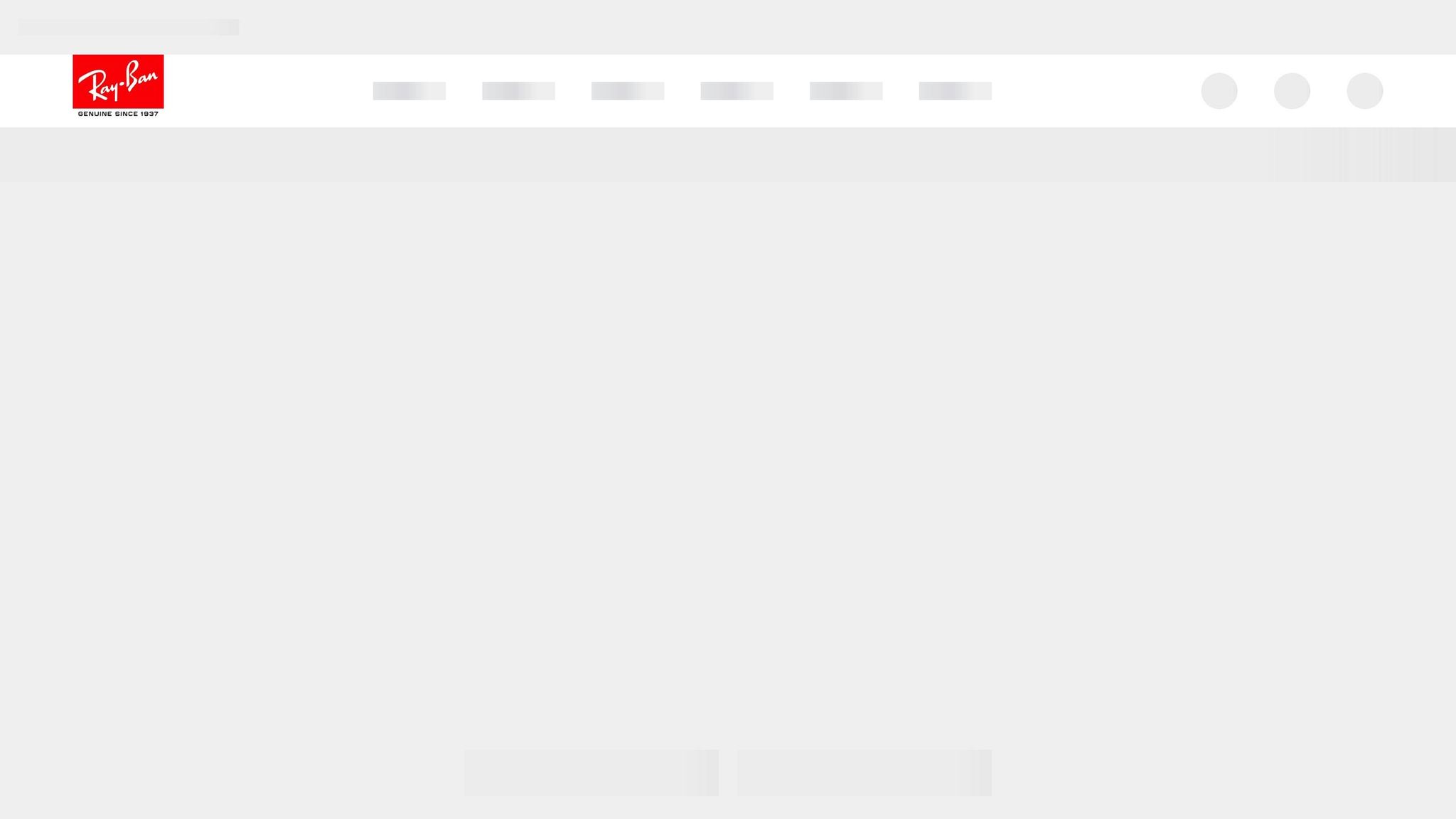
In 2025, Ray-Ban shook up the $146.1B global eyewear market with a cutting-edge AR fitting tool that redefined online shopping for glasses[1]. This tool combines user-friendly design with advanced technology to bring the feel of an in-store fitting to the digital world.
Using their device's camera, customers can see 3D, real-time views of Ray-Ban frames on their faces. The system uses detailed facial mapping to ensure frames fit correctly, offering a virtual try-on experience that feels personal and precise.
| Feature | Benefit |
|---|---|
| Real-time Frame Visualization | Gives a 360-degree view of how frames look on the face |
| Facial Mapping Technology | Ensures accurate fit recommendations based on facial structure |
| Multi-angle Views | Lets users see frames from every angle |
| Frame Size Recommendations | Suggests the best size for individual facial dimensions |
This initiative tackled a major issue in eyewear e-commerce: helping shoppers confidently choose frames that suit their style and fit needs. By offering a virtual try-on option, Ray-Ban boosted customer trust in buying glasses online[1].
The success of this AR tool highlights how technology is reshaping online retail, setting a new benchmark for interactive shopping - an idea explored further in this article.
2. Pizza Hut's PAC-MAN Game Experience
Pizza Hut shook up fast-food marketing with an AR PAC-MAN campaign that brought nostalgia to life. By transforming pizza boxes into interactive gaming platforms, they created a fun way to connect with customers and increase engagement.
The campaign used 8th Wall's image target technology, making gameplay smooth on both iOS and Android devices. With this approach, the game was accessible to about 5 billion smartphones globally [3]. Customers could dive into the game instantly by scanning a QR code on specially designed pizza boxes that featured the classic PAC-MAN maze [2].
| Feature | How It Worked | Why It Mattered |
|---|---|---|
| WebAR Technology | No app download needed | Easy and immediate access |
| Difficulty Levels | Three-tier system | Kept players engaged longer |
| Virtual Leaderboard | Tracked player initials | Encouraged friendly competition |
| Social Integration | Shared scores on Twitter | Boosted viral potential |
| Prize Incentive | Arcade1Up PAC-MAN cabinet | Motivated more participation |
George Felix, Pizza Hut's Chief Marketing Officer, highlighted how the campaign was part of their 'Newstalgia' initiative, blending iconic brand elements with modern experiences. Yutaka Fuse noted the perfect fit between PAC-MAN's design - shaped like a pizza with a missing slice - and Pizza Hut’s identity.
"There aren't many brands with more iconic elements than us, whether it's the red cups, checkered tablecloths, connection to pop culture and entertainment - like PAC-MAN - or our iconic Pan Pizza. As we look to connect with a new generation of pizza lovers, we are tapping into those things that make Pizza Hut great in a modern and relevant way." [3]
"Pac Man's design and creation was inspired by the shape of a pizza with a slice taken out of it, making this partnership so appropriate for the Pac Man brand." [2]
3. Coca‑Cola Zero Sugar AR Taste Test
Coca‑Cola took taste testing to a whole new level with an augmented reality (AR) campaign, blending physical products with digital experiences. Using AR technology, the company created a digital sampling experience that stood out.
Specially designed Zero Sugar cans featured QR codes that led users to an interactive AR experience via the Creations Hub. This allowed people to virtually "taste" the drink. The campaign achieved impressive results, as shown in the table below:
| Campaign Element | Performance Metrics | Impact |
|---|---|---|
| AR Vending Experience | 50,000+ app downloads | Boosted brand engagement |
| Digital Sampling | 250,000+ target audience reach | Broader market reach |
| Social Media Integration | 40,000+ YouTube views | Increased social sharing |
| In-Store Displays | Deployed across 28 markets | Strengthened retail presence |
The campaign also transformed how Coca‑Cola approached retail. Coca‑Cola Hellenic Bottling Company used AR technology to improve product placement strategies. Sales representatives utilized mobile devices to showcase virtual displays, streamlining negotiations and driving better conversion rates. According to an Augment Customer Story, "Augment® has completely revolutionized the sales process by allowing reps to create a realistic simulation of the ideal POS placement and share it with their clients. Coca‑Cola Hellenic's field reps can now close deals more efficiently, secure the best placement for their equipment, and help their buyers to make more informed decisions." [6]
"Coca‑Cola Creations is all about creating unexpected and magical moments for our fans. We wanted to create a refreshing, future‑themed drink that blends Coca‑Cola's signature taste with the power of artificial intelligence." [5]
Gamification added another layer of engagement. Users interacted with an 8-bit avatar named BYTE, collecting pixels while exploring a virtual world. This extended brand interaction and encouraged more social sharing [7].
Creative Director Zac Pritchard from AKQA summed it up perfectly:
"Everything we've created will permit our audience to #TakeATaste of Coke Zero Sugar for themselves, even if it's not theirs in the first place." [4]
4. NYX Virtual Makeup Testing
NYX Professional Makeup has reshaped online beauty shopping with their "Beauty Bestie" AR filter, created in collaboration with Snapchat. This tool allows users to virtually try on makeup looks and purchase products instantly, offering a new way for customers to explore and buy beauty items.
The tool’s personalization feature adapts based on user interactions, providing tailored product recommendations[8].
Key metrics from NYX's AR campaigns highlight its impact:
| Feature | Impact | Results |
|---|---|---|
| Virtual Try-On | Increased shopping confidence | 2.1M AR experiences[9] |
| Personalized Recommendations | Improved user engagement | 99.8% engagement rate[9] |
| Direct Purchase Integration | Simplified buying process | 638,500 impressions[9] |
| In-Store Scanning | Connected physical and digital | Instant access to tutorial videos[8] |
NYX has expanded its strategy with seasonal campaigns and integrated in-store features. For example, the "NYX Professional Makeup Haunted Dollhouse" experience - featuring makeup looks designed by artist Mimi Choi - achieved 637,400 unique opens in the Spanish market[9].
A Snapchat representative explained:
"The more you interact, the more it learns what you like, making it that much more personal over time"[8]
Additionally, customers can use a product scanning feature to access tutorial videos instantly, bridging the gap between physical stores and digital engagement[8].
This AR initiative tackles common challenges like shade matching and product testing while maintaining a personalized experience. The strong performance metrics demonstrate how AR technology is setting new standards in beauty marketing.
5. Pepsi Max AR Bus Stop Display
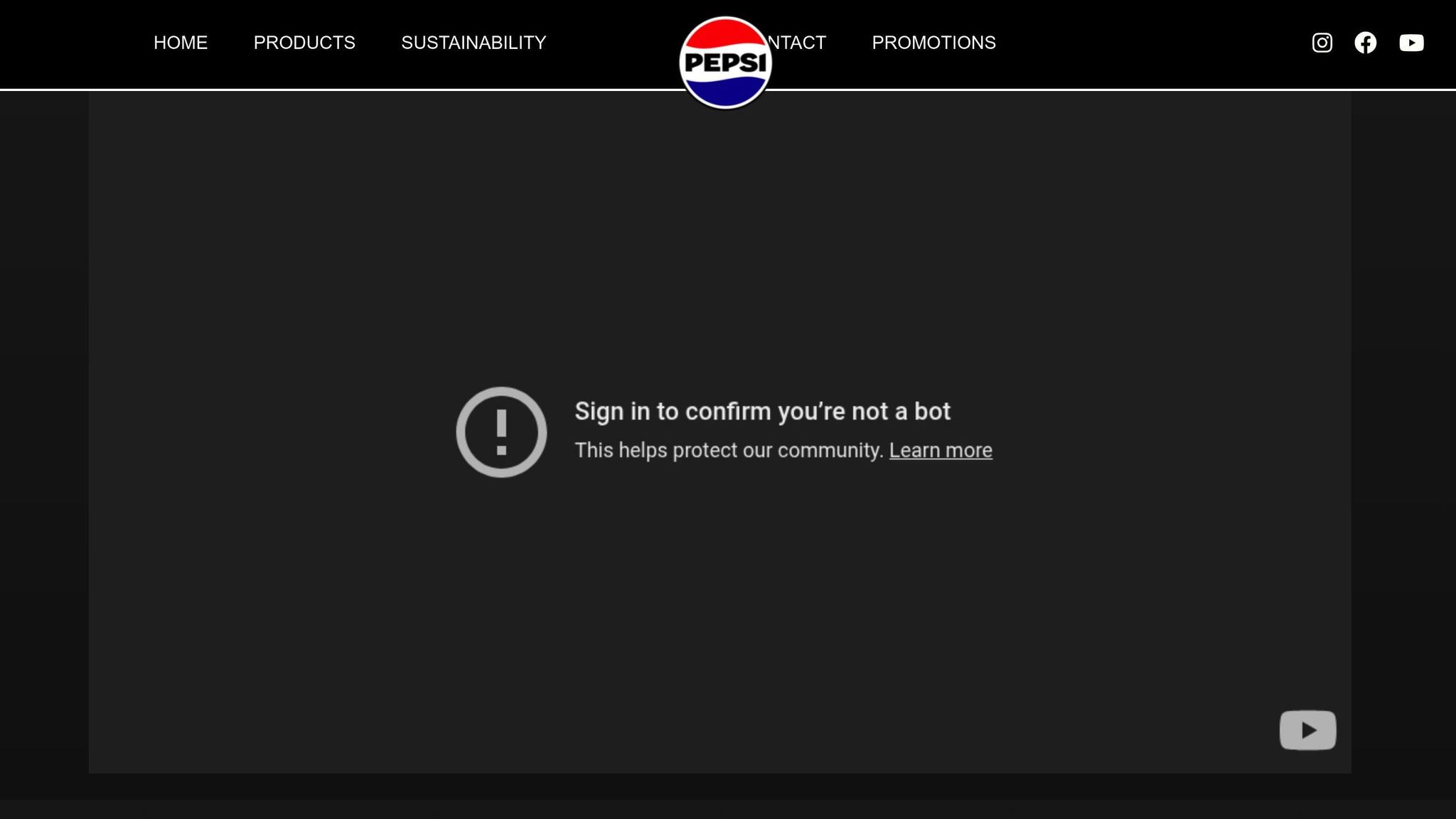
Pepsi Max took outdoor advertising to a new level with an AR bus stop installation that turned an ordinary bus shelter into an interactive, digital experience. Commuters waiting at the stop were treated to a live view of the street, enhanced with stunning augmented reality effects.
Using advanced depth mapping, the installation layered custom 2D and 3D visuals over a live video feed. People witnessed scenes like:
- A giant robot firing lasers
- A fiery asteroid crashing toward the street
- Tentacles creeping out of manholes
- Tigers prowling on the sidewalk
Campaign Results
| Metric | Result | Timeframe |
|---|---|---|
| YouTube Views | 8M+ total | Overall campaign |
| Initial Reach | 3M views | First 5 days |
| PR Coverage Reach | 385M people | Campaign duration |
| Earned Media Rate | 95% of impressions | Campaign duration |
| Sales Impact | 35% increase YoY | Campaign month |
Stephen van Elst, executive creative director at Spinifex Group, highlighted the installation's effectiveness:
"This is a great use of augmented reality to deliver a live experience. It's communicating a message - the idea of 'unbelievable.'" [11]
The installation's success was driven by several factors:
- Flawless integration of AR with real-world surroundings
- Creation of highly shareable and viral content
- Strong alignment between the technology and Pepsi Max's brand message
Annie Weinberger, general manager of Aurasma at HP Autonomy, also praised the campaign:
"This is a great example of how technologies like augmented reality offer a highly memorable and captivating experience. No one who was at the bus stop that day will forget that any time soon." [11]
The campaign's impact was further acknowledged with a Bronze Outdoor Lion award [10]. By capturing genuine reactions and turning them into shareable content, Pepsi Max set a new standard for public AR installations.
sbb-itb-5bde20f
6. Nike AR Footwear Preview
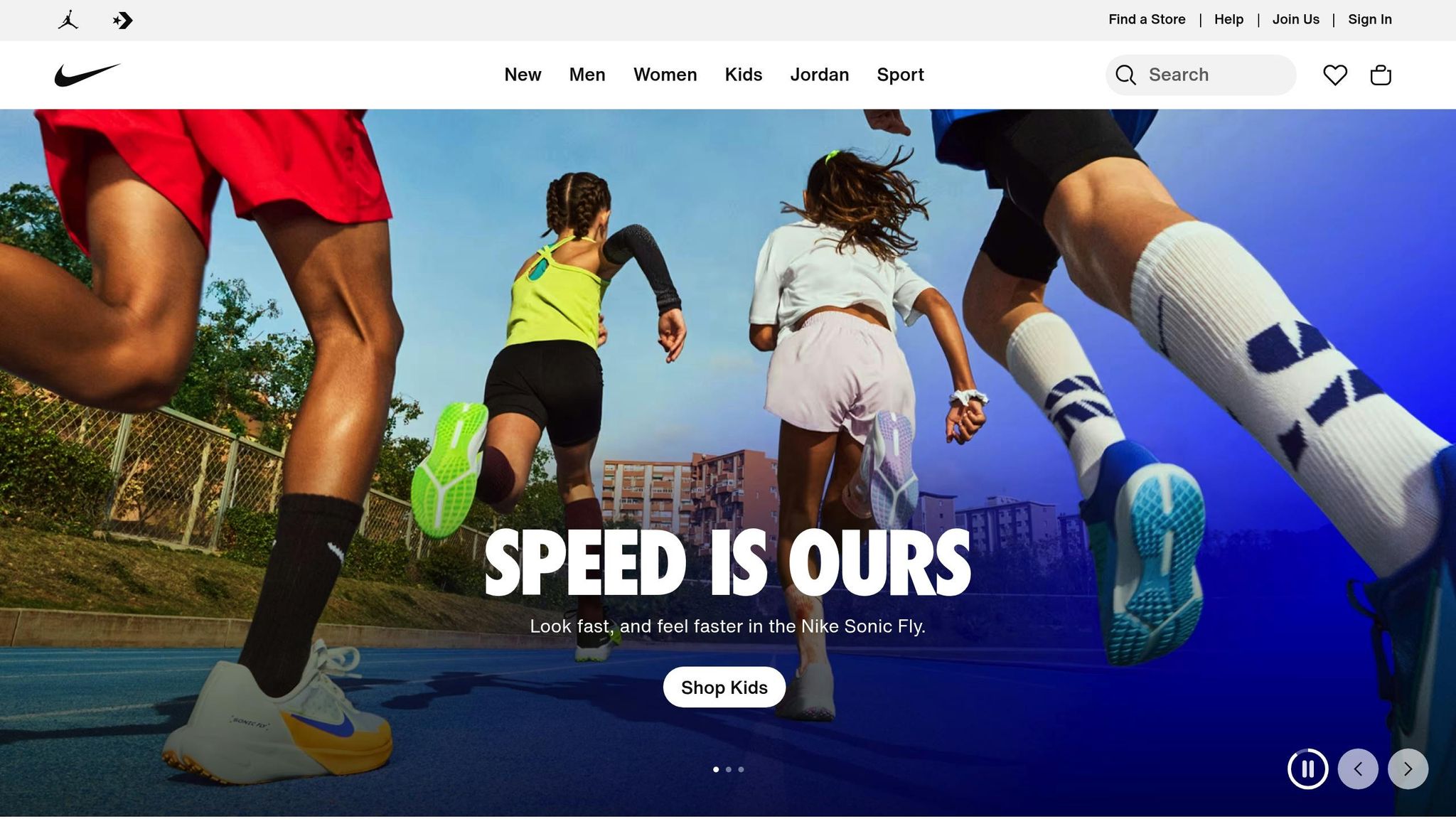
Nike is pushing boundaries in retail with its use of augmented reality (AR). At its Williamsburg store, Nike introduced AR features that allowed customers to virtually try on shoes and view them from multiple angles. The "Swoosh High" campaign, powered by Snapchat's AR Mirror technology[12], let shoppers experience real-time virtual try-ons and explore interactive features, including exclusive discounts.
Nike didn't stop at in-store experiences. They extended their digital reach through Foot Locker, using Snapchat's AR filter to bring a Nike poster to life. The poster featured LeBron James performing a slam dunk, creating a dynamic experience for viewers. This promotion gained massive traction, with over 2.2 million video views, 12,441 retweets, and 50,000 likes[13].
Here’s what made the campaign stand out:
- Real-Time Virtual Try-Ons: Shoppers could instantly see how shoes looked without needing physical samples.
- Interactive Features: The AR responded to movements and gestures, making the experience engaging.
- Social Media Integration: Customers could easily share their AR moments, amplifying Nike’s reach.
- Exclusive Discounts: AR-activated deals encouraged immediate purchases.
These features reshaped how customers interact with retail products. Nike's AR Footwear Preview raised the bar for engagement and influenced buying behavior in a big way.
7. Maybelline Digital Mirror Tool
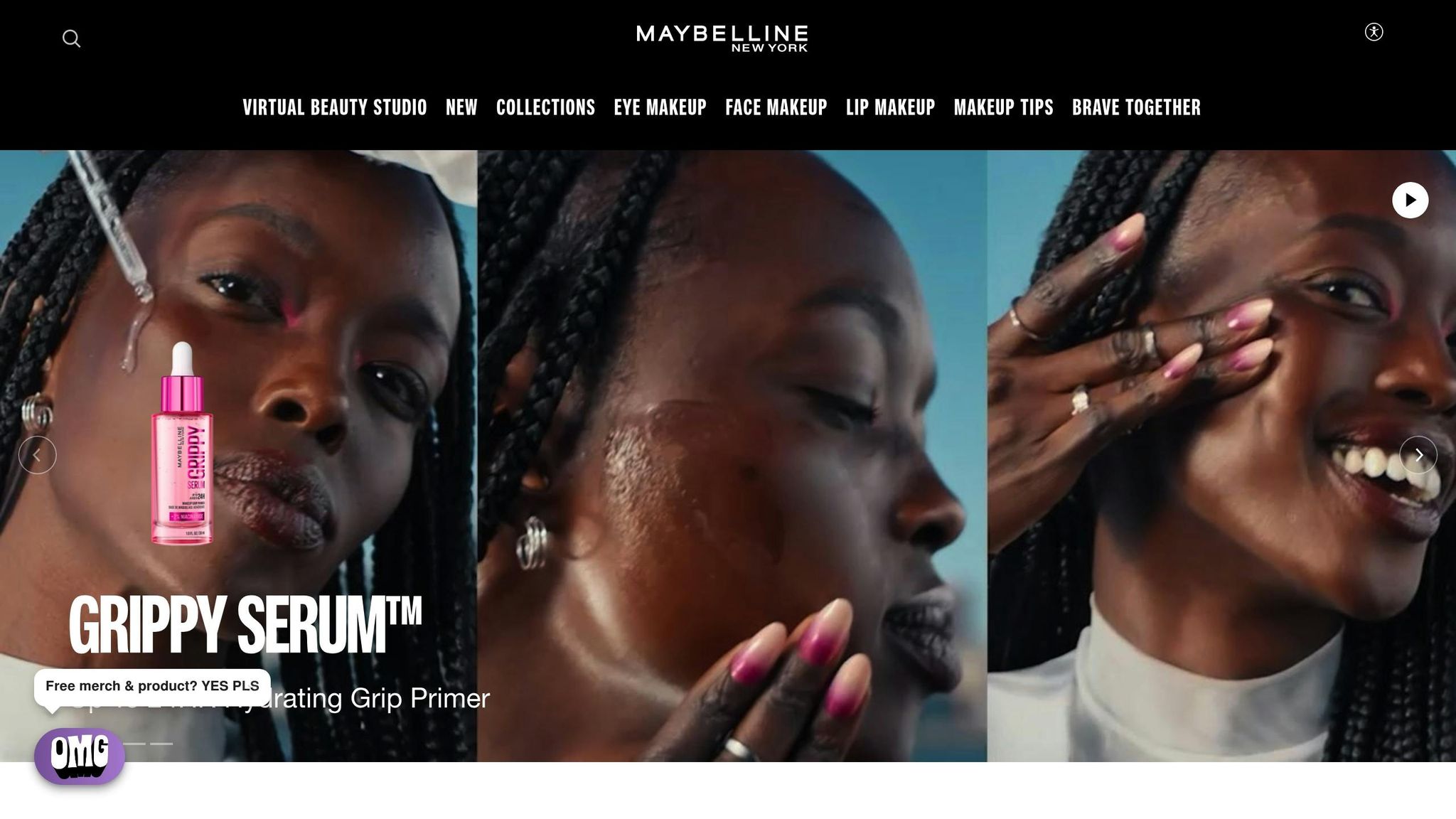
In 2025, Maybelline introduced its Digital Mirror Tool, a game-changing AR feature for beauty retail. This virtual try-on tool enhanced both customer engagement and conversion rates.
A study evaluating Maybelline's AR tool revealed a System Usability Scale (SUS) score of 77.61, highlighting its ease of use and high user satisfaction [14]. Key takeaways from its performance include:
- Accurate color matching, which helped build trust among consumers
- Smooth e-commerce integration, simplifying the decision-making and purchase process
- Reliable performance, ensuring a hassle-free user experience
While the tool excelled in areas like innovation, as noted by the User Experience Questionnaire (UEQ), it also pointed out the need to improve dependability to better mimic the in-store shopping experience.
In markets where online shopping dominates, this tool stood out by boosting customer confidence in purchasing beauty products without needing a physical trial.
Maybelline's Digital Mirror Tool sets a high standard for AR in beauty retail by combining accurate color representation, user-friendly design, and ongoing technical improvements.
8. Porsche AR Vehicle Display
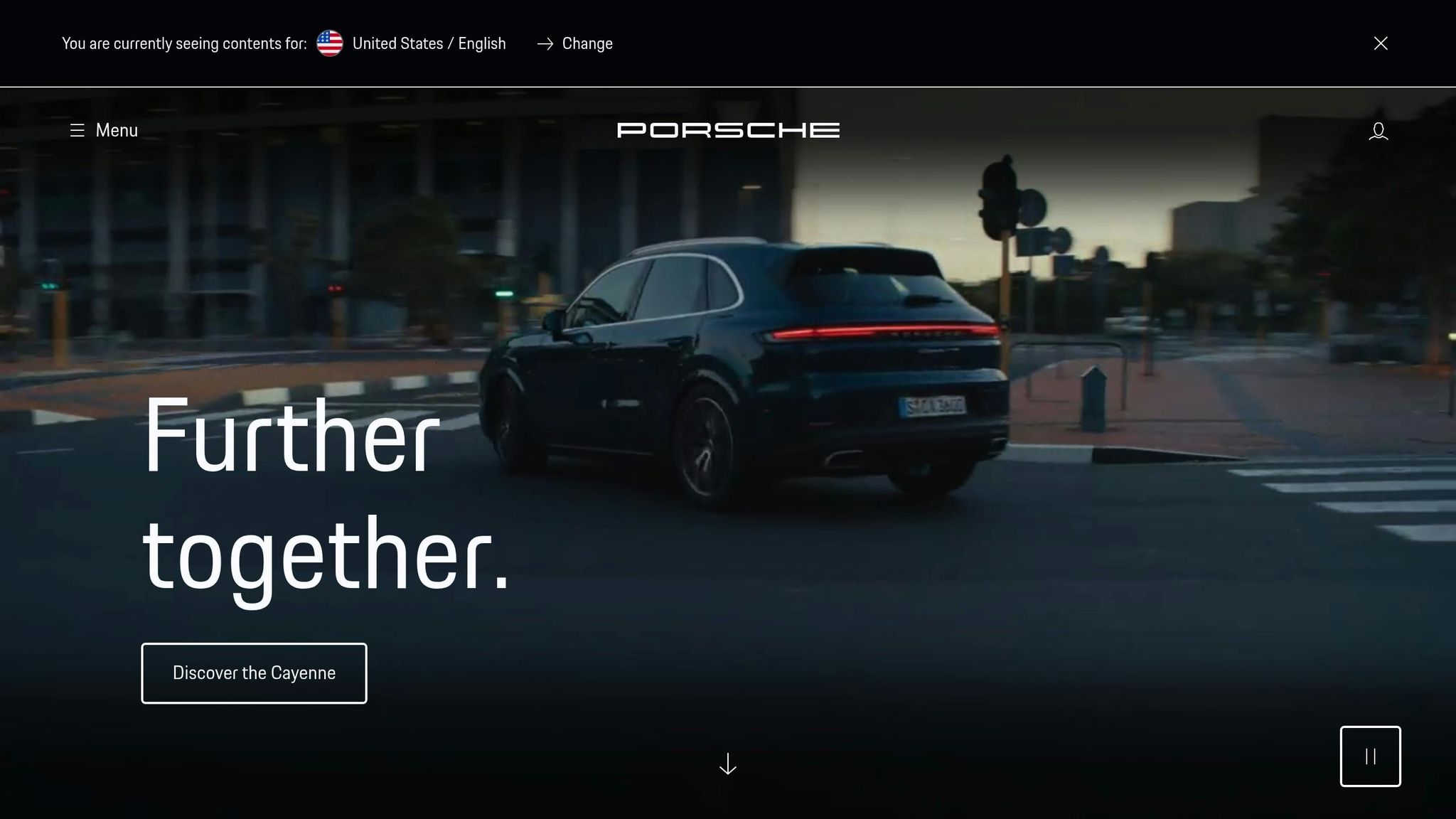
In 2025, Porsche elevated the luxury car buying experience with an updated version of its AR Visualizer App, first introduced in 2019. This app allows customers to explore and customize their dream Porsche in highly detailed 3D.
Here’s what the app offers:
- Photorealistic Rendering: 3D visuals that match the quality of Porsche's Web Configurator.
- Real-world Integration: Virtually place your configured Porsche in any setting, from your driveway to your living room.
- Technical Exploration: Use the highlight feature to reveal key details like the powertrain.
- Complete Product Range: Access Porsche's entire lineup in one place.
An expert at Porsche described the app’s impact:
"With our new app, the configuration of a Porsche will be even more of a digital experience. Now, before making the purchase decision, everyone can virtually park their dream Porsche in their own driveway, marvel at it in their own living room, or show a photo-realistic version to their friends." [15]
British motoring journalist Alex Goy also praised the app’s immersive capabilities:
"It was genuinely fascinating. I think it's an invaluable resource. There's an almost tangibility to the presentation [...] you can walk through it, you can reach out, and it's all to scale as well, so you get a deeper impression of the product, of what goes into it, and what you could do with it – which you definitely wouldn't get with a 2D show or a graphic on a screen." [16]
9. Burberry AR Bag Viewer
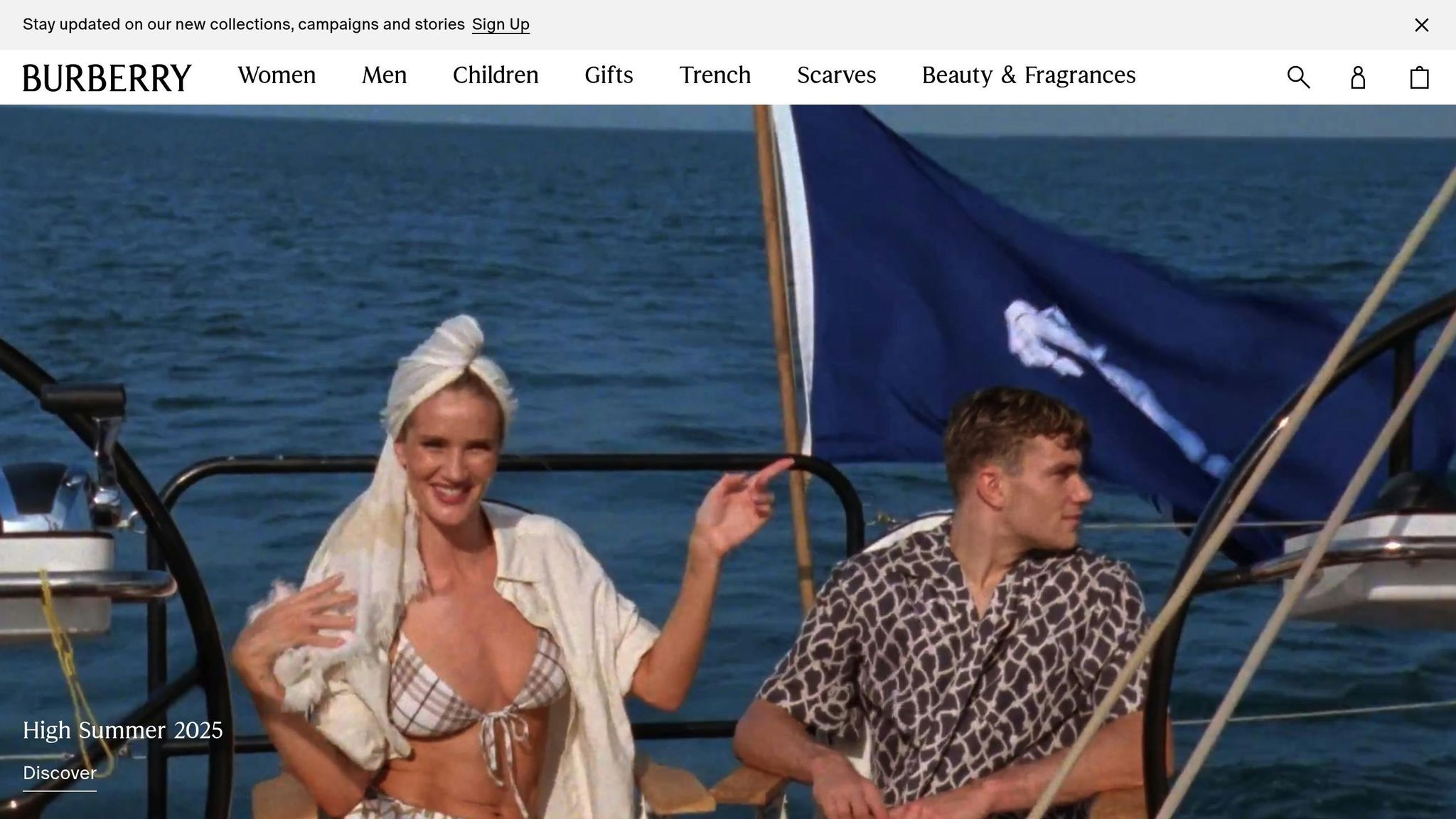
In 2025, Burberry elevated luxury handbag shopping with its AR Bag Viewer, offering an interactive way to explore the iconic Lola bag collection directly on its website.
With this feature, shoppers can:
- Use their smartphones to generate life-sized 3D models of the bags
- Place virtual bags in real-world settings
- Inspect details like the Thomas Burberry Monogram clasp up close
- Rotate the bags 360° for a complete view
- Virtually explore the interior compartments [17]
This technology, developed with Vertebrae (a Snap Inc. company), combines 3D capture, photogrammetry, and laser scanning to create highly detailed virtual replicas. The AR experience is integrated across 60 Lola product pages on Burberry.com [17].
Additionally, Burberry introduced interactive pop-ups where customers could scan a QR code to access an exclusive AR Instagram filter. This filter features both face and world lens options, allowing users to experience anti-gravity raindrop simulations in a dynamic and engaging way [17].
10. Netflix AR Anime Portal
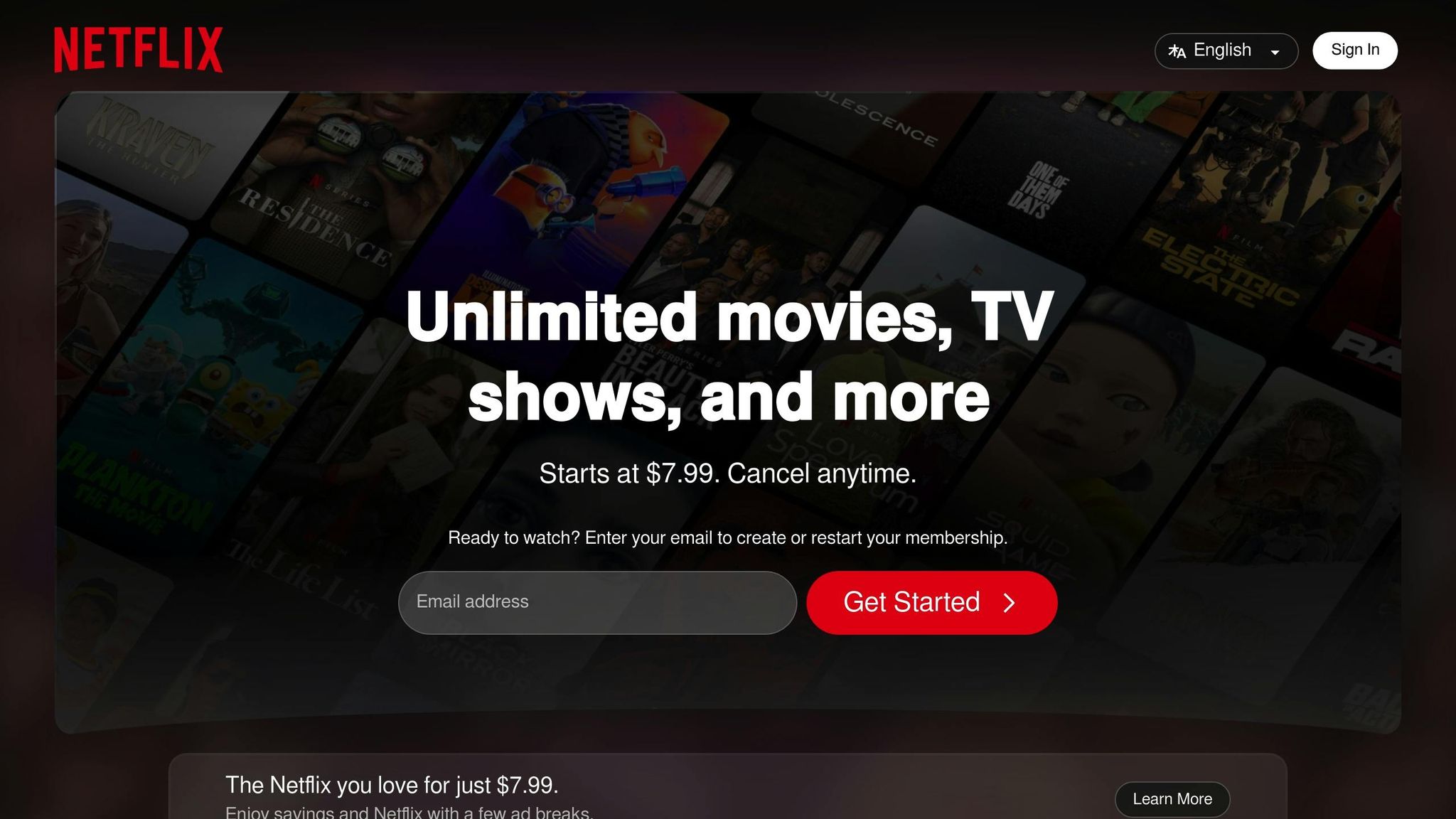
Netflix's AR Anime Portal takes anime promotion to the next level. By incorporating augmented reality (AR), it turns everyday spaces into interactive, anime-themed environments. These AR overlays let users dive into anime stories while also offering a glimpse into the cultural elements behind them. This campaign highlights how AR can strengthen audience connections and create experiences that stick with viewers. It’s a great example of how AR can boost engagement and leave a lasting impression.
Key Marketing Insights
The most impactful AR campaigns of 2025 reveal valuable lessons for marketers using augmented reality. The mobile AR market is projected to grow from $10.5 billion in 2023 to $21.5 billion by 2028 [18]. This growth highlights AR's potential to influence sales, reduce costs, and improve user experiences.
Boosting Sales and Engagement
Sephora's Virtual Artist app is a standout example, driving e-commerce net sales from $580 million in 2016 to over $3 billion by 2022 [18].
Reducing Costs and Scaling Effectively
IKEA's Place app demonstrated how AR can lower return rates while increasing customer satisfaction [18]. By 2028, the global AR/VR user base is expected to reach 3.67 billion [18].
Improving Customer Experiences
| Challenge | AR Solution | Result |
|---|---|---|
| Difficulty visualizing products | Virtual try-on tools | 42% increase in real estate investments |
| Lack of purchase confidence | Interactive product demos | Lower return rates |
| Limited brand interaction | Immersive experiences | 3,100 app downloads |
Best Practices for Technology Integration
The AR software market is expected to hit $13 billion in 2024 [18]. Successful campaigns often emphasize:
- Instant Product Information: Quick access to details and pricing.
- Interactive Branding: Creating unforgettable experiences.
- Smooth Integration: Enhancing the user journey without adding complexity.
These approaches set the stage for strong returns on investment.
Measuring ROI Effectively
To gauge success, campaigns focus on clear metrics, such as:
- App downloads and user activity
- Direct sales growth
- Improved customer retention
- Fewer product returns
- Higher social media engagement
- Longer AR interaction times
Next Steps
AR experiences are proven to be highly engaging, with a 200% increase in interaction, three times the memorability, and a 71% boost in shopping frequency among consumers [19]. These stats highlight the potential for your next AR project, inspired by successful campaigns like Ray-Ban's Virtual Fitting and Nike's AR Footwear Preview.
Getting Started with AR Marketing
Take inspiration from brands like L'Oréal, which increased e-commerce sales by 49% in 2019 using virtual try-on features [19]. To kick off your AR campaign, focus on solving specific customer challenges using these common AR applications:
| AR Campaign Type | Best Use Cases | Impact |
|---|---|---|
| Virtual Try-on | Cosmetics, eyewear, accessories | Builds purchase confidence, reduces returns |
| Spatial Preview | Furniture, home decor, electronics | Improves satisfaction, lowers return rates |
| Experience Campaigns | Product packaging, retail displays, print media | Boosts engagement, drives lead generation |
Creating Your First AR Campaign
Browser-based AR solutions remove the need for app downloads, making it easier for customers to engage. When designing your campaign, focus on these key elements:
- A seamless experience from first interaction to the final call-to-action
- Creative concepts that highlight AR's strengths
- Integration with your existing marketing efforts
AR campaigns often achieve dwell times of over 85 seconds and interaction rates as high as 20% [20]. Tools like Augmia's no-code platform make launching browser-based AR campaigns simple - start small with QR codes and expand as you gain traction.
Tags
Related Posts

WebAR Browser Compatibility: What to Know
Explore how browser compatibility impacts WebAR experiences and discover which platforms excel in delivering augmented reality through the web.

SLAM vs. Sensor Fusion: Hybrid Tracking in AR
Explore how hybrid tracking, combining SLAM and sensor fusion, is transforming AR by enhancing accuracy and adaptability across diverse applications.

Guide to Real-Time Object Detection for No-Code AR
Explore how no-code platforms are revolutionizing real-time object detection in augmented reality, making AR accessible for everyone.